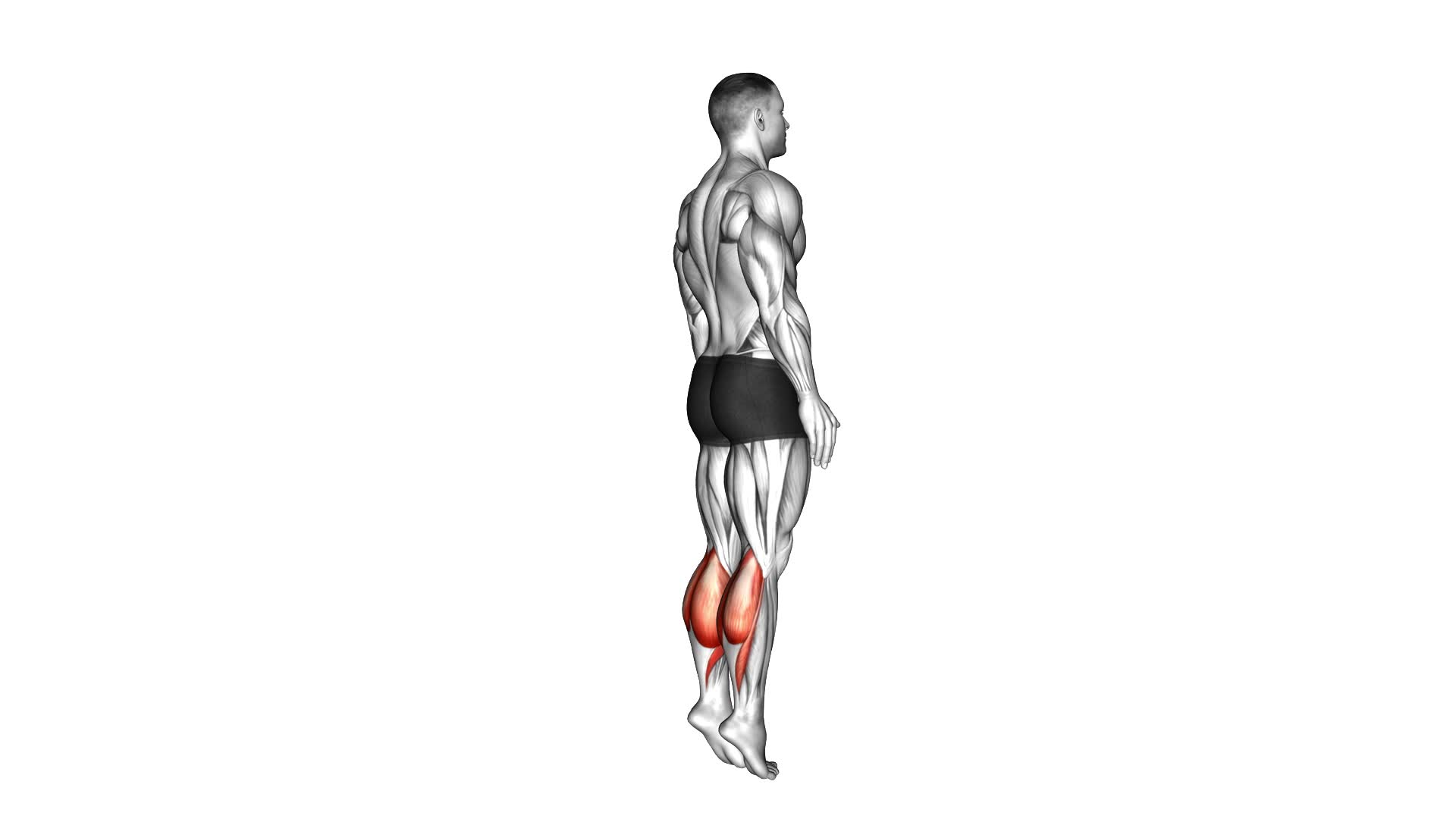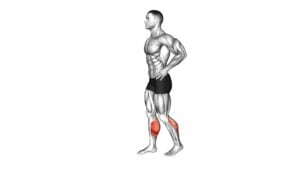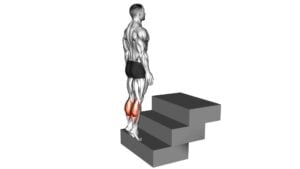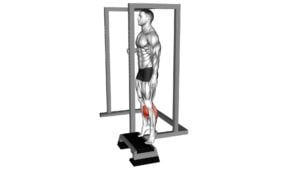Bodyweight Standing Calf Raise – Video Exercise Guide & Tips

Are you looking to strengthen and tone your calf muscles? Look no further than the Bodyweight Standing Calf Raise!
Watch This Exercise Video
In this video exercise guide, we'll show you the proper form and technique to perform this effective exercise. You'll also discover variations to challenge your calf muscles and tips to maximize your results.
Avoid common mistakes and get ready to sculpt strong and defined calves with this simple yet powerful exercise.
Let's get started!
Key Takeaways
- The bodyweight standing calf raise strengthens and tones calf muscles.
- It improves calf muscle endurance and performance in activities like running, jumping, and walking.
- The exercise targets the gastrocnemius and soleus muscles in the calves.
- It also helps prevent ankle sprains.
Benefits of the Bodyweight Standing Calf Raise
To maximize the benefits of the bodyweight standing calf raise, focus on the proper form and engage your calf muscles by pushing up onto your toes. This exercise is an effective way to strengthen your calf muscles using only your bodyweight. By performing this exercise regularly, you can increase the strength and endurance of your calves, leading to better performance in activities such as running, jumping, and walking.
The bodyweight standing calf raise is a great option for those who prefer bodyweight exercises as it requires no additional equipment. It targets the gastrocnemius and soleus muscles in your calves, which play a crucial role in stabilizing your ankles and propelling you forward during movement. Strengthening these muscles can also help prevent injuries such as ankle sprains.
In addition to strengthening your calves, the bodyweight standing calf raise can improve your balance and stability. By standing on one leg and raising your body onto your toes, you challenge the small muscles in your feet and ankles that are responsible for maintaining balance.
Now that you understand the benefits of the bodyweight standing calf raise, let's move on to discussing the proper form and technique for this exercise.
Proper Form and Technique for the Exercise
To perform the bodyweight standing calf raise with proper form and technique:
- Start by standing with your feet shoulder-width apart.
- Keep your core engaged and your back straight throughout the exercise.
- Begin by lifting your heels off the ground, rising onto the balls of your feet.
- Ensure that you maintain a controlled and slow movement to fully engage your calf muscles.
- Once you have reached the highest point, hold the position for a second or two to maximize the contraction in your calves.
- Lower your heels back down to the starting position, allowing your calves to stretch.
It's important to avoid bouncing or using momentum during the exercise, as this can reduce the effectiveness and increase the risk of injury. Additionally, be mindful of not arching your back or leaning forward, as this can put unnecessary strain on your lower back.
Variations to Challenge Your Calf Muscles
To further challenge your calf muscles, you can incorporate variations into your bodyweight standing calf raise exercise. By adding these variations, you can increase the intensity and target different areas of your calves. Here are three options to consider:
- Single-Leg Standing Calf Raise: Perform the exercise on one leg at a time. This variation increases the demand on your calves and improves balance and stability.
- Weighted Standing Calf Raise: Hold a dumbbell or kettlebell in one hand or use a weighted vest to add resistance to the exercise. This helps to further engage your calf muscles and increase the challenge.
- Elevated Standing Calf Raise: Place the balls of your feet on an elevated surface, such as a step or platform, while performing the exercise. This variation increases the range of motion and allows for a deeper stretch in your calves.
These variations can be used individually or combined for a more challenging workout. Remember to start with lighter weights or progress gradually to avoid injury.
Different equipment options, such as weights or an elevated surface, provide advanced modifications to the standing calf raise exercise, allowing you to continually challenge your calf muscles and make progress in your fitness journey.
Tips to Maximize Your Results
Maximize your results by incorporating these tips into your bodyweight standing calf raise routine. To ensure injury prevention and maximize calf muscle activation, it's important to focus on proper form and technique.
Firstly, make sure to warm up before starting your calf raise routine. This will help prepare your muscles for the exercise and reduce the risk of injury.
Secondly, maintain a slow and controlled movement throughout the exercise. Avoid using momentum or jerking motions, as this can strain your muscles and increase the risk of injury.
Additionally, pay attention to your foot placement. Keep your feet parallel and aligned with your hips to target the calf muscles effectively.
Lastly, remember to breathe properly during the exercise. Inhale as you lower your heels and exhale as you raise them, ensuring a steady flow of oxygen to your muscles.
By following these tips, you can maximize your results and achieve optimal calf muscle activation.
Now, let's move on to the next section and discuss the common mistakes to avoid during bodyweight standing calf raises.
Common Mistakes to Avoid
To avoid common mistakes during bodyweight standing calf raises, focus on maintaining proper form and technique. Here are three common mistakes to avoid when performing this exercise:
- Using momentum: It's important to avoid using momentum to lift your bodyweight during calf raises. Instead, focus on slow and controlled movements, allowing your calf muscles to do the work. This will help to maximize the effectiveness of the exercise and prevent injury.
- Lifting too high: Another common mistake is lifting your heels too high during the calf raise. This can put unnecessary strain on your ankles and decrease the effectiveness of the exercise. Instead, aim to lift your heels just enough to feel a stretch in your calves, without lifting them excessively high.
- Neglecting proper alignment: Proper alignment is crucial for engaging the correct muscles and preventing injury. Make sure to keep your feet parallel, with your toes pointing forward throughout the exercise. Additionally, maintain a straight line from your head to your hips, avoiding any excessive leaning or arching of the back.
Frequently Asked Questions
How Often Should I Perform Bodyweight Standing Calf Raises to See Results?
To see results from bodyweight standing calf raises, you need to perform them regularly. The frequency depends on your fitness level and goals. Generally, doing them two to three times a week is a good starting point.
However, if you want to see quicker results, you can increase the frequency to four or five times a week. It's important to listen to your body and gradually increase the intensity as you get stronger.
Can I Perform Bodyweight Standing Calf Raises if I Have a Knee Injury?
If you have a knee injury, it may not be advisable to perform bodyweight standing calf raises. Putting pressure on your knees during this exercise could exacerbate your injury. However, there are alternative exercises you can do that don't put as much strain on your knees.
These exercises focus on strengthening your calf muscles without compromising your knee health. Another option is to work on improving ankle mobility, as limited ankle mobility can contribute to knee pain during calf raises.
Can I Use Weights or Resistance Bands to Make the Exercise More Challenging?
To make the bodyweight standing calf raise more challenging, you can definitely use weights like dumbbells. Hold the dumbbells in your hands while performing the exercise to increase the resistance on your calf muscles.
Another way to amp up the difficulty is by incorporating plyometric movements into your calf raises. This involves adding explosive jumps or hops to engage the muscles even more.
Both methods will help you take your calf raise workout to the next level.
Are There Any Modifications for Individuals With Limited Ankle Mobility?
If you have limited ankle mobility, there are modifications you can make to the standing calf raise exercise.
One modification is to perform the exercise with your heels elevated on a block or step, which can help to reduce the range of motion required at the ankle joint.
Another modification is to perform ankle exercises that focus on improving ankle mobility, such as ankle circles and ankle dorsiflexion stretches.
These modifications can help you still work your calf muscles effectively while accommodating your limited ankle mobility.
Can Bodyweight Standing Calf Raises Help With Improving Balance and Stability?
Bodyweight standing calf raises can be a great exercise for improving balance and stability. By focusing on the muscles in your calves, these raises help to strengthen and stabilize your lower legs.
The bodyweight variation allows you to perform the exercise without any additional weights, making it accessible for all fitness levels.
Incorporating bodyweight calf raises into your routine can also help to improve ankle strength and mobility, further enhancing your balance and stability.
Conclusion
In conclusion, the bodyweight standing calf raise is a simple yet effective exercise for strengthening and toning your calf muscles. By following proper form and technique, you can maximize your results and avoid common mistakes.
Additionally, incorporating variations of this exercise will challenge your calf muscles even further. With consistent practice and dedication, you can achieve stronger and more defined calves.
So get ready to rock those summer sandals with confidence!

Author
Years ago, the spark of my life’s passion ignited in my mind the moment I stepped into the local gym for the first time. The inaugural bead of perspiration, the initial endeavor, the very first surge of endorphins, and a sense of pride that washed over me post-workout marked the beginning of my deep-seated interest in strength sports, fitness, and sports nutrition. This very curiosity blossomed rapidly into a profound fascination, propelling me to earn a Master’s degree in Physical Education from the Academy of Physical Education in Krakow, followed by a Sports Manager diploma from the Jagiellonian University. My journey of growth led me to gain more specialized qualifications, such as being a certified personal trainer with a focus on sports dietetics, a lifeguard, and an instructor for wellness and corrective gymnastics. Theoretical knowledge paired seamlessly with practical experience, reinforcing my belief that the transformation of individuals under my guidance was also a reflection of my personal growth. This belief holds true even today. Each day, I strive to push the boundaries and explore new realms. These realms gently elevate me to greater heights. The unique combination of passion for my field and the continuous quest for growth fuels my drive to break new ground.



